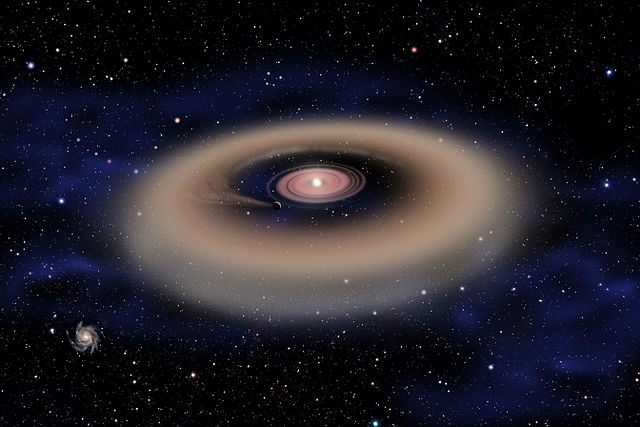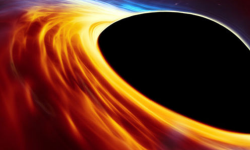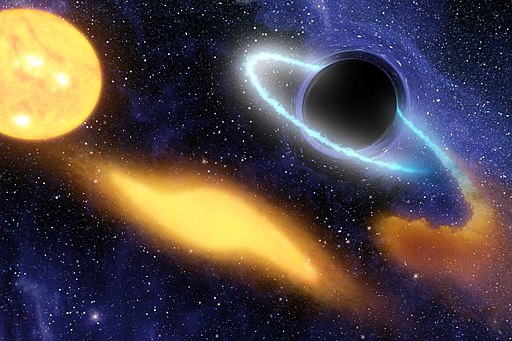
Chile’s Very Large Telescope (VLT) photographs a protoplanetary disk
– News of July 10, 2018 –
In the last few decades, a planetary system creation model has been established. It explains that in the creation of the solar system and other systems that we can observe come from a gravitational collapse in a molecular cloud, which gives rise to a proto-star. The surrounding matter rotates and flattens to form a disk around the star. When this protoplanetary disk cools, its matter agglomerates and collides to form planets. This is why in our system all the planets turn in the same direction and almost on the same plane. This model is based on many observations. Nebulae with stars in formation, already formed planetary systems and even protoplanetary disks have been detected, but the formation of planets within these protoplanetary disks has never been confirmed. It is now done : we observed a planet in formation within its protoplanetary disk. This photo was taken thanks to the Sphere instrument of ESO’s Very Large Telescope (VLT) in Chile.
The photographed system is very young. It is centered around a dwarf star that is five to six million years old. The planet being formed in the disc is a mastodon of almost ten times the mass of Jupiter. It orbits very far from its star, about the same distance as Uranus orbits the sun. The planet is also very hot with a temperature estimated at 1000 degrees Celsius, which facilitated the detection by direct imaging. It should cool down over the next few million years.
The photographed system is now one of the strongest proofs that the standard model for creation of planetary systems is correct. By multiplying these observations, we will also be able to understand a little better the youth of our own solar system. This observation is finally a testimony of the progress of the techniques of detection of exoplanets by direct imaging. The Sphere instrument and its coronograph has already proven several times its ability to image protoplanetary disks. Such an instrument coupled with the european giant telescope for example could allow us to admire the first clichés of earth-sized exoplanets, and even to study their atmosphere directly in search of gas associated with life. For this, we will have to be patient since the european giant telescope will not enter service before the second half of the next decade. In the meantime, we may have the chance to discover other young planetary systems at different stages of their formation, to understand a little better what is happening in the youth of a planet.

The discovery of a hot Jupiter challenges the theoretical models of star creation
– News of November 7, 2017 –
NGTS-1 is a red dwarf located 600 light-years from Earth. Around this star orbits a hot Jupiter, that is to say a planet of size equivalent or superior to Jupiter and whose average temperature is quite high. This hot Jupiter would have a temperature of 530 degrees Celsius. The discovery of the giant planet was announced on October 31 and has been widely talked about. Discover a gas giant is not exceptional because they easiest exoplanets to detect. But finding a hot Jupiter around a dwarf star is not common. This even raises some theoretical problems.
To explain the creation of planetary systems, astronomers use a model called the nebula hypothesis. According to this model, stars are created by gravitational collapse of hydrogen clouds. This results in a protoplanetary disk around the star. The protoplanetary disk can then generate the creation of one or more planets. The problem is that the protoplanetary disk of a red dwarf is in theory not massive enough to allow the formation of a hot Jupiter. It will therefore be necessary to review the model because we just observed one.
This is not the first time that a hot Jupiter-like planet has challenged the creation patterns of planetary systems. 51 Pegasi b, also called Dimidium, is the first exoplanet to have been discovered around a star in 1995. It is a gas giant that orbits very close to its star. But the models of the time stipulated that gaseous giants could exist only in the outer parts of their systems, as in our solar system. It was because of it that we had to invent the classification of hot Jupiter for gas giants who have a very high temperature near their star.
The discovery announced last week is interesting because it is the first to have been really observed using a new instrument called NGTS (Next-Generation Transit Survey), consisting of twelve telescopes equipped with 20 cm mirrors. They work together to continuously monitor the brightness of several hundred thousand stars. They should make it possible to discover planets whose size can go down to twice the terrestrial diameter. The discovery of many planetary systems will allow us to understand what is normal and what is exceptional within our galaxy.
Image by David A. Aguilar, CfA (NASA overview of 215th annual AAS) [Public domain], via Wikimedia Commons









